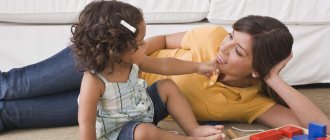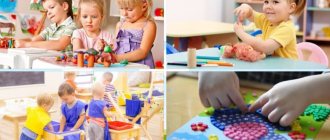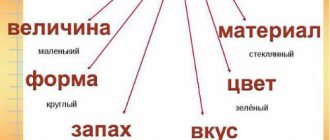Goals:
- Clarify the articulation of the sound “O”.
- Learn to pronounce the sound “O” correctly.
- Learn to intonate the sound “O”.
- Develop articulatory, fine and gross motor skills, auditory attention.
- Develop the ability to listen to the speech of a speech therapist, skills of cultural behavior.
Equipment: Olya doll, ring, hoop, picture of a girl pronouncing the sound “O”, tape recorder with a recording of a melody for singing the sound “O”.
Progress of the lesson
Children enter the group and sit in a semicircle.
1. Game “The doll Olya came to visit us.”
— The doll Olya came to us. Look what happened to her? (The Olya doll has a bandage on her cheek.) She has a toothache and groans like this: Oooh.
- We hold our cheeks with our hands and groan together: Oh-oh-oh.
- Now let’s send the doll Olya to the doctor, let him help her.
2. Articulation gymnastics.
- To beautifully pronounce and sing the sound “O”, you need to do gymnastics (5 times each exercise):
- open your mouth wide - close it;
- show a long tongue - remove;
- the tongue runs left and right;
- show teeth;
- tube - stretch your lips forward with tension (teeth closed);
- smile (stretch your lips in a smile);
- inflate and deflate cheeks.
3. Singing the sound “O” in chorus (to melody No. 1)
- Let's sing together. – Hold your cheeks (to form an oval of lips).
- Let's all sing together. They put their hand on the neck.
- Let's all sing together. They put their hand on their chest.
4. Exercise “Ring”.
Show the children the ring. Pay attention to its shape. Then make a ring on your lips.
5. Outdoor game “Baba sowed peas.”
| Oh-oh-oh-oh! Baba was sowing peas! | Children hold their hands to their cheeks, shake their heads to the sides, and use their fingers to imitate how to sow peas. |
| Oh-oh-oh-oh! Our peas have grown big! | Hands to the cheeks, shake your head to the sides, rise on your toes, pull your arms up. |
| Oh-oh-oh-oh! It's hard to carry peas! Oh-oh-oh-oh! | Hands to cheeks, shaking head to the sides. They lower their hands down. Hands to cheeks, shaking head to the sides. |
| Oh-oh-oh-oh! Our peas have rolled! Oh-oh-oh-oh! | Hands to cheeks, shaking head to the sides. They are running. Hands to cheeks, shaking head to the sides. |
6. Finger gymnastics.
- Make a ring with your left hand. (Connect the thumb and index fingers of your right hand and make a ring. Pronounce the sound “O” briefly.)
- Now with your left hand.
- With both hands.
7. Summary of the lesson.
- Look, the Olya doll has returned from the doctor and her cheek is no longer tied, which means she has recovered! And I brought you souvenirs!
Literature.
- Fomicheva M.F. Raising children's correct sound pronunciation: Workshop on speech therapy; Textbook manual for students of pedagogy. school for special 0308 “Preschool education”. - M.: Education, 1989,
- Working with non-speaking children using the method of Novikova-Ivantsova T.N. /melody No. 1
Tasks:
- Educational. Introduce students to the vowel sound [o] and the letter O. To consolidate the characteristics of this sound (articulatory and acoustic properties).
- Developmental. Develop phonemic processes: phonemic perception, phonemic analysis and synthesis, representations based on phonemic perception.
- Develop speech and auditory memory, attention, logical thinking.
Progress of the lesson
I. Organizational moment.
We stood up and straightened up. The children will sit down and tell me a word-object whose name contains the vowel sound [a].
II. State the topic and purpose of the lesson.
Name the same sound in the words: cat, house, dream. Sound [o]. Today in class we will get acquainted with the sound [o] and the letter O. A postcard flew to us, but on the way it scattered into 5 parts. We have to collect it. For each part you need to complete a task. First, let's do articulation gymnastics.
III. Articulation gymnastics. (Various articulation exercises can be used)
- "Painter". Open your mouth. Use the tip of your tongue to move along the hard palate, moving from the upper front incisors to the soft palate.
- "Horse". Suck your tongue to the hard palate and click your tongue. Try to pull the hyoid ligament.
- "Fungus". Open your mouth. Suck your tongue to the hard palate and, without lifting your tongue, pull the lower jaw down.
IV. Main part.
Exercise 1
Characteristics of sound [o]. This is a vowel sound because it can be sung, pronounced in a drawn-out manner. There is no obstruction in the mouth. Let's look at the modules and select the sound module [o].
The first task has been completed, you can receive the first part of the postcard. Task 2
Reading a poem. Find and remember words with the sound [o].
The wolves went hunting, by the way, they say. Wolves eat berries.
Children take turns naming words that contain the sound [o].
The second task has been completed, you can receive the second part of the postcard.
Task 3
Find pictures whose names contain the sound [o].
Cat, mole, elephant, house, cake, hare, beetle, cheese, snail, doll. Take one picture each.
Draw a diagram for your picture and note the sound [o].
You have completed this task, you can receive the next part of the postcard.
Task 4. Rebus
Highlight the first sound in the names of each picture. By connecting all the first sounds, you will find out what children love.
JUICE
You have completed the fourth task, you can receive the next part of the postcard.
V. Physical exercise. Let's stretch our fingers.
They came to visit the thumb (show thumb) right to the house, (make a house out of palms) index and middle, (show index finger) ring and last. (show ring and little fingers) The little fingers themselves knocked on the threshold. Together they are friends, they cannot live without each other.
VI. Independent work of children (in a notebook).
Write the letter O o.
You have completed the fifth task, you can receive the last part of the postcard.
VII. Bottom line .
- What did we study?
- What words came to visit?
- What new did you learn?




